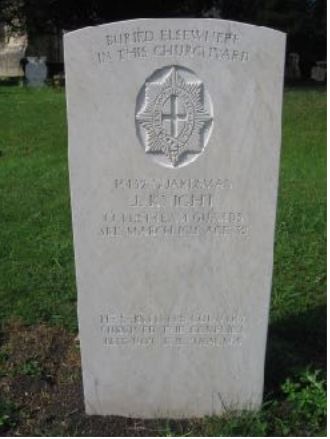5th (Reserve) Battalion, Coldstream Guards

John Knight was born at Itchingfield, near Horsham, Sussex in 1885, possibly the only child of George and Fanny Knight.
Prior to the Great War he appears to have undertaken general labouring and gardening work. In the latter part of 1911, he married Kate Elizabeth Ellen Beard at Horsham. Kate, (sometimes known as ‘Kitty’) originated from Gloucestershire, having been born at Standish in 1882. At the time of the 1911 Census she was employed as a domestic nurse to the family of a retired Lieutenant Colonel of the Indian Army and his family, who lived at Itchingfield.
John and Kate had three children, James Edward (born 12 March 1912), Dorothy (born 18 March 1914) and Annie (born 30 March 1916). All appear to have been born in Horsham.
Unfortunately, as is often the case, John Knight’s Army Service Record was destroyed due to enemy action in 1940. However, various other records have survived to assist in piecing together at least some details of his military service.
He probably attested for military service on 19 December 1915, under ‘Lord Derby’s Scheme’, which was the precursor of full military conscription. His regimental number of 18432 indicates that he was not actually called up until early June 1916. It is not known to which battalion of the Coldstream Guards he was posted. There were four main line battalions plus the 5th, which was a Reserve Battalion, whose function was to feed drafts of replacement troops to the main battalions. John would have been placed on the strength of this battalion having returned from the Western Front.
A set of documents which has survived at the National Archives, as part of the Army Pension files, relates to Guardsman Knight’s discharge. From these we know that at the time of attestation he was a gardener and that he served on the Western Front with the British Expeditionary Force (BEF) from 5 January to 26 May 1917. His military character was considered ‘good’ and he was ‘a hard working man’. He gave an address for correspondence as Mrs H Beard (presumably his mother-in-law), Whitminster. It seems likely that John, having been called up for military service, Kate, with three young children to look after, returned to live with her mother in Gloucestershire.
John was discharged from the Army on 2 October 1917, at the age of 32 years and four months, having served for one year and 318 days. The reason for his discharge was that he had suffered from ‘POU’ (Pyrexia of Unknown Origin) or ‘trench fever’, a generally debilitating condition brought about by active service conditions. This had manifested itself in March 1917 and was due to exposure, in what was one of the coldest and wettest winters on record in Northern France. He was also mentally ill, probably suffering from what became known as ‘shell shock’. He was awarded a Silver War Badge, to denote his discharge from military service and a permanent 50% disability pension.
The story of what happened to John Knight following his discharge is well described in this extract from the Cheltenham Chronicle of 9 March 1918:
On Sunday (3 March 1918) the body of discharged soldier named John Knight was found in a disused well at Moreton Green, Moreton Valence. Knight, who lived with his wife and family at Whitminster, had suffered from trench fever and shell shock and received a discharge from the Army in October last. He was certified insane and admitted to the County Asylum where he remained until January 19th. At the inquest the jury returned a verdict to the effect that the man drowned himself in a fit of insanity and the foreman said they wished to add a rider expressing strong disapproval of the action of the military authorities in sending the deceased home in such a state. It was nothing short of scandalous and disgraceful to think that such a thing could be permitted. The Coroner, in recording the verdict, said he would add a rider to the effect suggested by the jury.
John Knight was buried in the churchyard of St Andrew’s Church, Whitminster, on 7 March 1918, aged 32. If he had a marker for his grave this either disappeared or deteriorated over the years and effectively his grave was lost. His name did not appear on the Commonwealth War Graves Commission (CWGC) Register of the dead from the Great War – a not uncommon occurrence where a soldier had been discharged but subsequently died from an active service related condition, prior to the cut off date at the end of August 1921.
Someone must have identified this anomaly and put forward the necessary evidence through to the Ministry of Defence and the CWGC, through the medium of the In From the Cold Project, whose aim is to obtain recognition for cases such as that of Jack Knight: acceptance followed on 22 July 2016. Unfortunately, his actual grave plot with the churchyard could not be identified and as a result the CWGC erected a headstone bearing the inscription ‘Buried elsewhere in this cemetery’, which is termed a ‘Special Memorial’. Unusually in such cases a specific inscription has been added to the headstone which reads ‘He served his country: survived the conflict but not the trauma. The presence of such an inscription indicates that the CWGC was successful in tracing a relative of John Knight, who chose the wording.
John’s wife Katy never remarried and died in 1935, aged 55 and is also buried in St.Andrew’s Churchyard.
The story of Guardsman John Knight is a tragic one: a hard working family man who suffered physically from his time in the trenches and mentally from the horrors he experienced. After about a century he has been honoured in the place of his burial and will now be remembered in perpetuity in the register of the CWGC.
Researched by Graham Adams 29 July 2019
